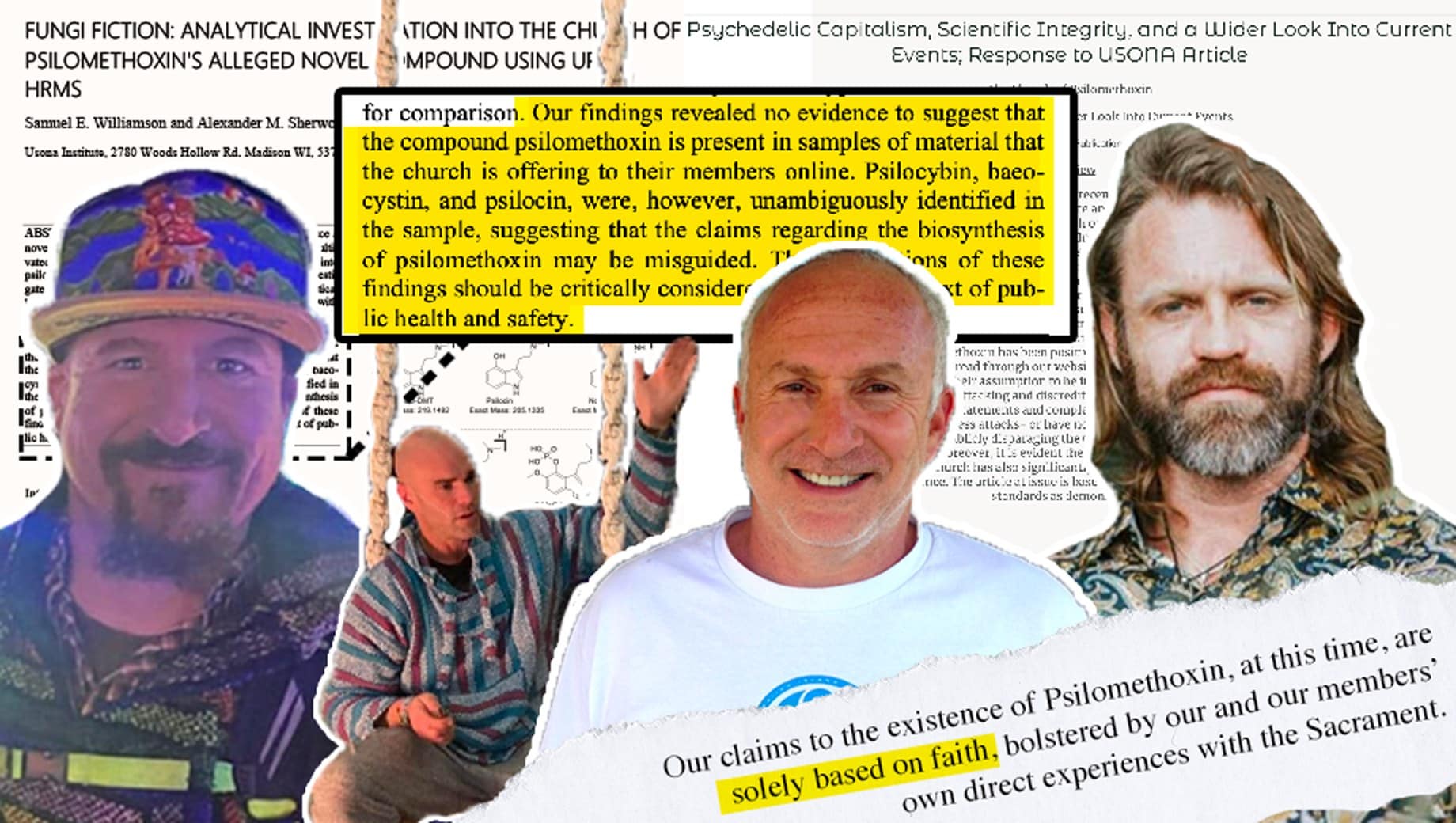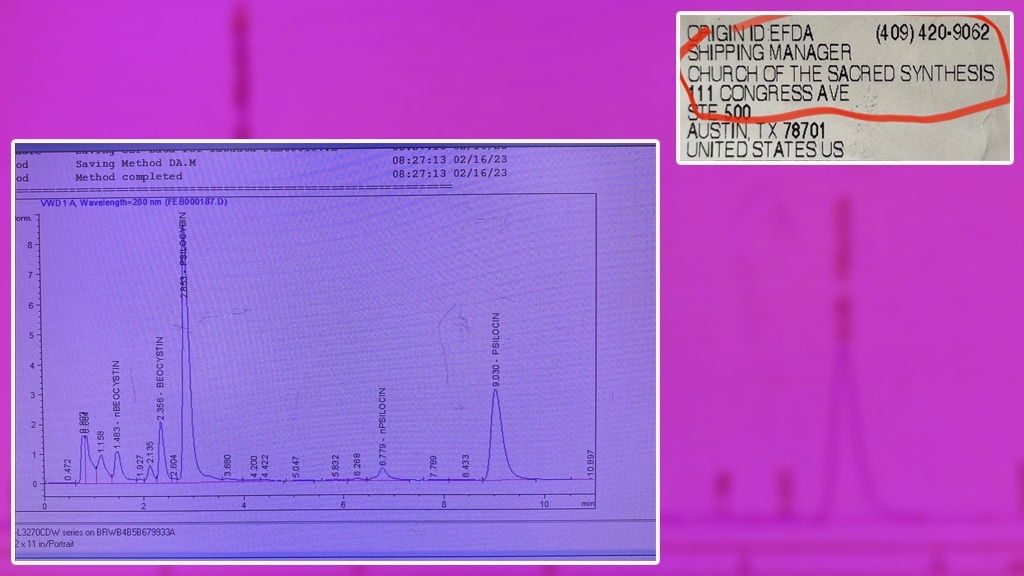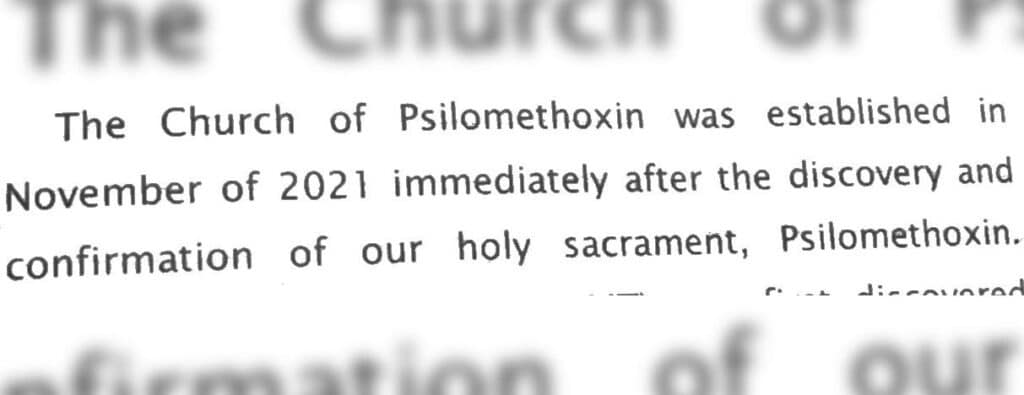
Russell Hausfeld contributed to the reporting of this story.
Editor’s note: As Psymposia was preparing to publish this article, the Church of Psilomethoxin changed its website and social media channels to refer to it as the “Church of the Sacred Synthesis.” Given that the events reported in this article occurred when the Church was calling itself the “Church of Psilomethoxin,” Psymposia has decided to continue using that name for the sake of clarity.
What happens when a group of veterans and lawyers start a psychedelic church?
It sounds like the start of a bad joke, but since Veterans Day 2021, it’s been a question that an increasing number of people have been asking about The Church of Psilomethoxin (CoP). This recently-formed “entheogenic church” — started by Ian Benouis (who participated in Psymposia’s 2015 Drug War Stories), Greg Lake, Benjamin Moore, and Ryan Begin — recognizes the drug psilomethoxin as its “universal sacrament” and “sacramental supplement,” and has been promoting its services and sacrament on a number of podcasts and social media outlets. This has left many wondering what exactly psilomethoxin is, and just how this church allegedly became the world’s largest manufacturer and distributor of this esoteric compound practically overnight.
On its website and in various interviews, CoP claims to have developed a novel biosynthetic approach for producing its sacrament, allegedly by adding 5-MeO-DMT to the growing substrate of Psilocybe cubensis, which purportedly caused the fungus to convert the 5-MeO-DMT into psilomethoxin within the mushroom fruiting body. Throughout 2022, CoP’s homepage claimed that the “fruiting bodies contain only Psilomethoxin (a non-scheduled substance) and not psilocybin and psilocin” (emphasis added).
Once the Church approves prospective members and receives a membership fee of $55.55, the Church advertises that it ships powdered psilomethoxin-containing mushroom fruiting bodies — its spiritual sacrament — to its members for $175 for a half-ounce or $300 per ounce.
To say that these claims raised eyebrows among psychonauts would be an understatement. For years, underground chemists on web forums like the DMT-Nexus have explored “doping” mushroom substrates with a variety of chemicals, from tryptamine HCl to melatonin, and posting their findings (including analytical results) for discussion. In January of this year, a post titled “4-HO-5-MeO-DMT & The Church of Psilomethoxin” appeared on the 5 Hive forum. Two months later, in March, skeptical responses began to pop up in the thread, eventually accompanied by analytical results from high-performance liquid chromatography with ultraviolet detection (HPLC-UV) on a sample reportedly obtained from CoP. The analysis failed to detect psilomethoxin or other unexpected compounds, but did detect psilocybin, psilocin, and baeocystin.

On April 12 it became apparent that CoP’s claims had caught the attention of researchers operating beyond the realms of online drug forums. Usona Institute chemists Samuel Williamson and Alex Sherwood released a preprint manuscript (a preliminary version of a scientific paper made available prior to peer-review) titled, “Fungi Fiction: Analytical Investigation into the Church Of Psilomethoxin’s Alleged Novel Compound Using UPLC-HRMS,” detailing their analysis of “purported psilomethoxin material” provided by the Church, using ultra performance liquid chromatography with high-resolution mass spectrometry (UPLC-HRMS). The sample for their analysis was provided to the chemists by an anonymous CoP member, whose identity Psymposia has independently verified.
Upon analyzing the sample from the Church, the researchers concluded that their results “strongly indicate that the material distributed by the Church of Psilomethoxin does not contain the novel compound psilomethoxin (or 5-MeO-psilocybin) as claimed.” The paper closes by stating that the Church’s “claims of producing a novel compound, psilomethoxin, by incorporating 5-MeO-DMT into the substrate of cultivated Psilocybe mushrooms are more akin to ‘fungi fiction’ than reality,” asserting that, “our analysis revealed that the material distributed by the Church primarily contains known tryptamines, specifically psilocybin and psilocin, with a trace amount of baeocystin.”
In other words, CoP appears to be sending plain old cubensis mushrooms through the mail — at a markup of $50-$200/oz compared to the street prices reported by Erowid.
The Church was quick to respond to the preprint, publishing a statement titled “Psychedelic Capitalism, Scientific Integrity, and a Wider Look Into Current Events; Response to USONA Article” on April 13.
The statement, riddled with errors and self-contradictory claims, offers a case study in psychedelic charlatanism. For instance, throughout CoP’s response, it references Facebook comments by David Heldreth of Panacea Plant Sciences (a corporadelic firm whose website raises far more questions than it answers) and repeatedly conflates Heldreth and his comments with the preprint by the Usona chemists Williamson and Sherwood.
When questioned about the Church confusing authorship of the preprint, Greg Lake, one of CoP’s founders, claimed the language in the Church’s response was intended to highlight Heldreth’s statements as defamatory. “A republish is just as liable as the original publisher is what I was getting at there,” Lake told Psymposia. However, the final section of CoP’s response explicitly refers to the preprint as “Williamson and Heldreth’s paper,” an error that Lake’s explanation fails to address.
In order to avoid muddying the waters further, Psymposia has chosen to focus its reporting on the points raised by the Usona researchers and CoP’s replies to those points.
Before unpacking the Church’s statement, it should be noted that on April 14, CoP’s website was set to forward all pages to entheogenesis.io. The redirect led to a $300 per ticket “one-day very intimate consciousness event” hosted by CoP and scheduled for the following day, where the “Sacrament, Psilomethoxin will be offered in ceremony for further expansion and connection to unity consciousness in their experiences throughout the day in a safe and loving container.” The Church also removed public access to its Facebook, Instagram, and YouTube pages. By April 20, it appeared CoP had begun deleting social media pages, with its Instagram profile returning an error message, rather than a private profile; but by April 23, it had returned to a publicly visible private page.
To summarize, in the days following the release of the preprint by Usona researchers, CoP leaders responded with an evasive denial and effectively took the Church website and social media channels offline. At the same time, they forwarded people to their in-person event where they planned to distribute the recently-debunked sacrament. Lake said the Church’s online presence was minimized because recent interactions were causing “very negative energy [in] our team.”
When CoP’s website flashed back online on April 21, a message read “At this time, we are only accepting members who have been referred by another member and verified,” and most of the site’s content was only accessible to members. Most pages simply read, “This content is for Members only” and invited members to log in with their credentials. The website went offline on April 22, but on April 23 it reappeared, again with most of its content only accessible to Church members.
Returning to the response itself, perhaps the most notable point the Church offers is its assertion that, “The individuals attacking and attempting to discredit our Church, seemingly operate off the erroneous assumption that the Church has made the claim that Psilomethoxin has been positively identified in its Sacrament. Had they taken time to read through our website content and other materials, they would have known their assumption to be incorrect.”
Read it once. Read it twice. Then read it again. Yes, you read it correctly. The Church of Psilomethoxin says that it has never claimed to have positively identified psilomethoxin in its sacrament. However, in numerous materials reviewed by Psymposia, CoP has repeatedly asserted that its sacrament is psilomethoxin. So if the Church’s sacrament is psilomethoxin, how is it possible that its psilomethoxin doesn’t contain any psilomethoxin?
A review of CoP documents offers insight as to the claims the Church has made. For example, its Welcome Book for New Members explicitly states, “The Church of Psilomethoxin was established in November of 2021 immediately after the discovery and confirmation of our holy sacrament, Psilomethoxin” (emphasis added). While lawyers are known for splitting hairs — and this is a Church whose founders repeatedly emphasize their legal backgrounds — it seems unreasonable for the Church to argue that it never “made the claim that Psilomethoxin has been positively identified” when CoP’s own documents explicitly cite its “confirmation” of psilomethoxin.

If we can avoid getting hung up on the contradictory notion that the Church of Psilomethoxin has never claimed to have “positively identified” psilomethoxin “in its Sacrament [psilomethoxin],” there’s a litany of claims from CoP’s website that bear examining.
For example, on a page titled “Psilomethoxin: The History, Testing, Pharmacodynamics, and Pharmacokinetics,” the Church states:
“An Anesthesiologist MD [medical doctor] in the US who is a member of our church purified the molecule and injected it into numerous persons subcutaneously and reported no adverse responses.”
In light of CoP’s statement that it never positively identified psilomethoxin, how could it claim this anesthesiologist purified an unidentified, possibly non-existent molecule? It also raises the far more alarming question of what, exactly, this anesthesiologist “purified” and injected into “numerous persons” — especially given that they were “purifying” fungal material.
One can’t help but think back to the case study published in 2021, which purportedly documented the case of “a 30-year-old man who injected psilocybin [‘mushroom tea’] intravenously resulting in an extended stay in the intensive care unit because of multiple-system organ failure.”
Psymposia asked Greg Lake about the claims of purification and subcutaneous injection, which CoP published on its website. Lake was quick to deny any official Church involvement, saying, “It was just merely reported to us. It wasn’t done at our direction or anything like that. So yeah, no, we didn’t like pay or command or get anybody to do that.” Lake did not elaborate as to if or how CoP attempted to verify the claims of purification and injection prior to posting them on its website, or why Church leadership chose to amplify these claims, specifically.
In a bout of apparent honesty further down the “Testing” section of the page, the Church admits:
We have performed GC-MS [gas chromatography–mass spectrometry] multiple times on our sacrament and to date, no one has been able to detect the molecule using this destructive testing process.
According to the Church, it was unable to identify the presence of psilomethoxin via repeated analysis with gas chromatography–mass spectrometry. In other words, CoP has no evidence for the presence of psilomethoxin in its mushrooms.
However, despite a lack of any supporting evidence, CoP leadership argues this actually means that the mushrooms did contain psilomethoxin, but the analysis process destroyed the psilomethoxin in the sample. It would seem more plausible that CoP’s attempts at psilomethoxin biosynthesis failed, and that the cubensis mushrooms — which no one has demonstrated can produce psilomethoxin — failed to produce any psilomethoxin for the Church. Instead, CoP asserts:
GC-MS methods are not capable of directly analyzing drugs that are nonvolatile (does [sic] not vaporize easily), polar (water soluble), or thermally labile (destroyed by heat).
We believe that Psilomethoxin is non-volatile, polar, and thermally labile and therefore a poor candidate for testing through this process.
Our church personally bioassays each batch of our sacrament for efficacy and safety.
Apparently, rather than analyzing their samples via other methods like readily-available HPLC (as in the case of the 5 Hive forum member) or UPLC (as in the case of the Usona researchers), the Church leaders decided that their repeated inability to identify psilomethoxin via GC-MS analysis, combined with bioassays (eating the mushrooms) actually indicated that the mushrooms “contain only psilomethoxin…and not psilocybin and psilocin.” When asked about these types of claims, Lake told Psymposia, “People have that right as an individual human to make a decision on what they want to consume themselves or not. And now, like you say with the [Williamson and Sherwood] article, there’s plenty of information out there. People can read the article, believe it, or, you know, talk to one of our members and believe them. You know?”
In numerous podcast interviews (1, 2, 3, 4, 5) CoP founders Lake, Benouis, and Moore state outright, imply, or fail to correct podcast hosts who say that CoP’s sacramental mushrooms contain “only a non-scheduled substance,” “psilomethoxin,” “mostly psilomethoxin,” “little to no psilocybin,” and other similar statements. Despite the Church’s recent denials, it seems clear that any reasonable person would understand these statements as CoP leadership claiming that the Church of Psilomethoxin grows and distributes mushrooms that contain psilomethoxin.
CoP’s April 13 reply to Williamson and Sherwood contains numerous ad hominem fallacies and generalized objections to the preprint, while offering minimal, if any, supporting evidence. At various points, the Church states:
“…these parties seem to be so fixated on attacking and discrediting the Church that they have either seen the Church’s statements and completely disregarded them (because it doesn’t support their baseless attacks) or have not taken the time to assess the entire situation before publicly disparaging the Church.”
“…it is evident their desire to try and discredit and disparage our Church has also significantly and negatively affected the quality of their science.”
“…the article at issue is based upon extremely poor scientific standards.”
“…scientifically, the claims made in the subject article are highly dubious at best.”
“…the subject article is of such a poor scientific/methodological standard…[it] is not reflective of them meeting [US Food and Drug Administration (FDA)] standards.”
While there are numerous additional examples throughout CoP’s response, this list offers evidence of the Church’s generally dismissive statements about the Usona researchers’ findings. Furthermore, the claims about FDA standards appear to be a red herring and are particularly odd in light of the Church’s admission that it has also been unable to identify psilomethoxin in any of its samples and simply believes in its presence as a matter of “faith.”
When questioned, Lake directed all questions regarding scientific claims to the Church’s “Director of Sacred Science/Sacred Synthesis,” Adam McKay, who declined Psymposia’s request to elaborate on why the Church referenced FDA standards or how they would be relevant to Williamson and Sherwood’s analytical findings.
Setting aside CoP’s list of vague objections, the Church’s response can largely be classified as falling into three arenas: claims about chemistry, faith, and “psychedelic capitalism,” all of which will be covered in upcoming articles. Psymposia has contacted additional psychedelic chemists and researchers to weigh in on the Church’s various claims.
When asked about a number of chemistry-related claims, McKay told Psymposia, “I will not be commenting anything [sic] for 4 months [sic] time other than the fact that I am proceeding in the direction of validating a proposed mechanism and producing a reference standard for the church.”
Hey! Before you go… Psymposia is a 501(c)(3) non-profit media organization that offers critical perspectives on drugs, politics, and culture. We strive to ask challenging questions, and we’re committed to independent reporting, critical analysis, and holding those who wield power accountable.
Our perspectives are informed by critical analysis of the systemic crises of capitalism that have directly contributed to the unmitigated growth of addiction, depression, suicide, and the unraveling of our social relations. The same economic elite and powerful corporate interests who have profited from causing these problems are now proposing “solutions”—solutions which both line their pockets and mask the necessity of structural change.
In order for us to keep unpacking these issues and informing our audience, we need your continuing support. You can sustain Psymposia by becoming a supporter for as little as $2 a month.